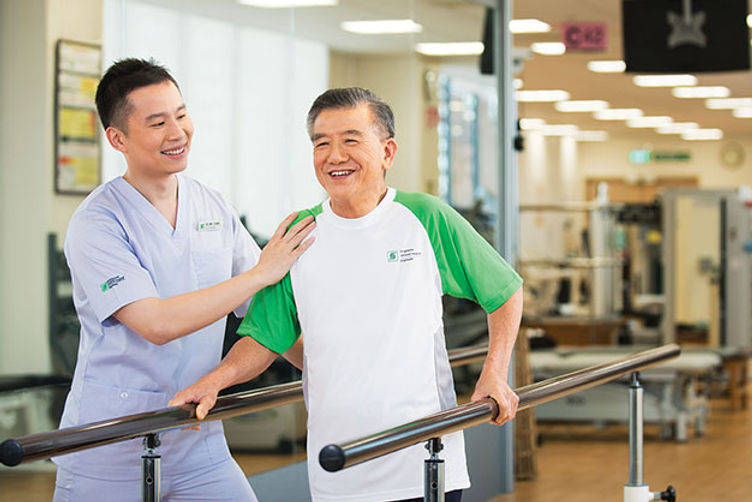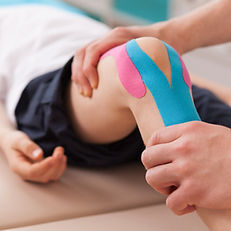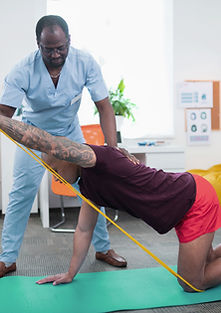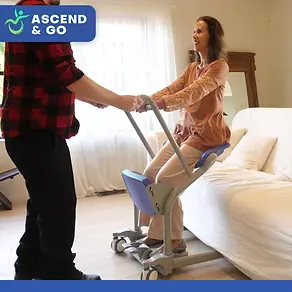Physiotherapy
Physiotherapy stood out as a domain where innovation can directly improve recovery and quality of life. We investigated how physiotherapists work with patients and where current tools may fall short, especially in fast-paced or resource-limited environments.

1.Domain Analysis
We began by building foundational knowledge understanding key terminology, context, and existing practices within the domain. This ensured that we shared a common language with stakeholders and could engage meaningfully without misunderstanding technical terms.
What Is Physiotherapy?
-
Involves the assessment, treatment, rehabilitation and prevention of pain, injury, or any other physical dysfunction and health condition, through the use of education, exercise, manual therapy, and other treatment modalities with the aim of maximizing the quality of life for individuals.
What is Muscle Atrophy?
-
Muscle atrophy is the wasting or thinning of muscle mass. It can be caused by disuse of your muscles or neurogenic conditions. Symptoms include a decrease in muscle mass, one limb being smaller than the other, and numbness, weakness and tingling in your limbs. Disuse atrophy can be reversed with exercise and a healthy diet.
Physiotherapy includes:
-
Physical rehabilitation
-
Prescribing exercises, manual therapy, electro-physical agents, and assistive devices
-
Assessing movement disorders (from infants to elderly) through:
-
Clinical exams & tests
-
Motion analysis (goniometry, dynamometry, etc.)
-
Exercise/bioimpedance testing
-
Mobility & function evaluations
-
-
Restoring normal movement patterns
-
Health promotion & disease prevention

Human Movement Analysis Techniques:
-
Goniometry: Measurement of joint range of motion using specialized instruments. Essential for assessing baseline function, guiding treatment plans, and tracking rehabilitation progress. Clinicians rely on these objective measurements to develop and adjust therapeutic interventions while monitoring patient improvement. A fundamental assessment technique that remains clinically valuable despite evolving tools.
-
Dynamometry: Measurement of muscle strength, particularly grip strength, using a portable device (hand dynamometer). Clinically useful for assessing overall function, nutritional status, and rehabilitation progress. A reliable objective measure that correlates with broader health indicators.
-
Posturography: Measurement of postural stability through analysis of center-of-pressure (COP) displacement using force platforms. Assesses balance by quantifying postural sway (path length, velocity, or area) during stance. While COP generally reflects center-of-mass position, discrepancies occur during dynamic movements. A key tool for evaluating balance disorders and neurological function.

2.Stakeholder Interview
We conducted open-ended, non-leading interviews with domain experts to learn about their standard operating procedures (SOPs) and the challenges they face. This step helped us uncover real-world pain points without introducing bias.
Bernadine Teng Sze Kee, Assistant Professor, Health and Social Sciences, Singapore Institute of Technology
Q1: Are there mechanical devices to reduce physiotherapist strain during sit-to-stand assistance? Why aren’t they used more?
A1: In hospitals, hoists help transfer patients between surfaces (e.g., bed to chair) but don’t assist sit-to-stand directly. Some chair-mounted devices may exist, but they’re not always practical for therapeutic training, where speed and active patient effort are prioritized. Limited availability and time constraints also limit their use.
Q2: Does your approach change with taller/heavier patients during transfers?
A2: We don’t "carry" patients due to safety policies. For larger patients needing maximal assistance, we avoid manual lifts and may use a standing tilt table (transfer from bed to an adjustable table tilted upright) or enlist extra help. Seated-to-standing transfers may be skipped if unsafe.
Q3: This standing to the table is like total assistance, where it's like the person just sit on the table, then they just automatically move the machine?
A3: No, it's not like a chair, it's like a piece of a bed or a flat surface. And then you just tilt them. So it doesn't go into standing.
Q4: How does the sit-to-stand method differ for stroke, orthopedic, and elderly patients?
A4:
-
Stroke patients: Focus on compensating for one-sided weakness (e.g., supporting the weaker limb/trunk while the stronger side propels movement).
-
Elderly (frail/deconditioned): Assist with overall weakness (e.g., aiding both legs, emphasizing thigh/core strength loss). May overlap with stroke if present.
-
Orthopedic (e.g., post-op knees/hips): Pain and fear of movement are primary barriers; support focuses on pain management and confidence-building.
Q5: What are the main muscle groups trained during sit-to-stand, and how can we provide mechanical support without hindering patient effort?
A5: Key Muscle Groups:
-
Hip/Knee Extensors (glutes, quadriceps) for rising
-
Ankle Dorsiflexors/Plantarflexors for forward momentum and stability
-
Core/Trunk Stabilizers to control forward lean
Biomechanics:
-
Starting Position: Feet properly placed (not too far forward/back)
-
Movement Phases: Forward trunk lean (momentum) → push through legs (extension of hips/knees/ankles)
Mechanical Support Options:
-
Adjustable Chair Height (higher seats reduce effort)
-
Firm Surface (softer surfaces like sofas increase difficulty)
-
Armrests (allow patients to assist with upper body)
-
Partial Support Devices (e.g., overhead lift straps, sit-to-stand aids) that assist without fully replacing patient effort
Considerations:
-
Avoid over-supporting to preserve therapeutic muscle activation.
-
Chair design (height, firmness, armrests) significantly impacts independence.
Q6: What devices (other than hoists/tilt tables) are commonly used for gait/balance exercises?
A6:
-
Walking Aids: Standard or automated walkers, ceiling-mounted body weight support systems (for treadmill/overground gait training)
-
Exoskeletons: Knee-assist devices for pain reduction during movement
-
Pedal Bikes: Portable pedal exercisers for lower limb mobility
-
Resistance Tools: Bands, weights, or devices like "Gymonic" for home-based strength training
For Home Use: Focus on simple, accessible tools (resistance bands, pedal bikes) to help seniors/stroke patients maintain strength and mobility independently.
Q7: How do you ensure patients adhere to home exercise plans?
A7: Patient adherence is challenging but key factors include:
-
Personal Relevance – Exercises must align with the patient’s goals and preferences. If they don’t see value, they won’t do it.
-
Enjoyment & Ease – Equipment/exercises should be user-friendly and engaging.
-
Discipline & Motivation – Self-driven patients are more likely to comply.
-
Clear Purpose – Patients must understand why the exercises matter for their recovery/function.
Q8: How do you track and document patient recovery progress?
A8: We use a mix of objective measurements and patient-reported feedback:
-
Objective Measures:
-
Functional Tests:
-
30-Second Sit-to-Stand (repetitions measure leg strength/endurance)
-
10-Meter Walk Test (gait speed)
-
Stair Climbing (mobility assessment)
-
-
Strength Testing: Handheld dynamometer for muscle strength tracking.
-
-
Patient Self-Reporting:
-
Feedback on daily function (e.g., "I can now get up from bed/toilet independently").
-
-
Adherence Tracking:
-
Exercise Diaries (simple tick-box logs)
-
Video Comparisons (caregivers film movements for visual progress proof)
-
-
Why It Works:
-
Combines data-driven metrics (reps, speed, strength) with qualitative feedback.
-
Video documentation helps patients see improvements, boosting motivation.
-
Q9: Do large transfer machines (with straps) include monitoring systems to measure patient strength?
A9:
Current Machines: Primarily for safe transfers/mobility (no strength monitoring).
Alternative Tracking:
-
Research uses accelerometers (step counting).
-
Clinics rely on functional tests (e.g., 5x sit-to-stand, balance, gait speed).
-
Tech Solutions: Apps (e.g., Korea’s SPPB tool) combine tests (balance, sit-to-stand, gait) into one scored system for efficiency.
Q10: Can AI analyze patient movement videos?
A10:
Yes! AI could help by:
-
Automating gait analysis (frontal/side/back views)
-
Tracking progress with simple visual reports for patients
-
Using wearable sensors for easy, real-time feedback
Q11: Is a physiotherapist present during walking/gait exercises? What support is provided?
A11:
-
Minimal Assistance Needed: Patients use parallel bars for hand support.
-
Independent Patients: Practice near walls for safety (can grab if unbalanced).
-
Structured Training: Environment is set up (e.g., straight-line walking) to challenge balance safely.
-
Ideal Support: Equipment that helps balance training while ensuring safety.
Q12: Can we create a system to support patients during walking practice (e.g., auto-adjusting chair/safety catch)?
A12:
Yes! A smart support system would help when:
-
Patients suddenly need to sit (fatigue/balance loss)
-
Therapists/assistants work alone (extra safety layer)
Key Features Needed:
-
Automatic chair positioning
-
Fall prevention/catch mechanism
-
Lightweight & easy to use
Why It Matters: Reduces therapist strain while keeping patients safe during independent practice.
("Smart safety systems = safer walking, less therapist fatigue.")
Q:13 Could an automated follow-chair improve gait training safety?
A13:
-
Current Challenges:
-
Narrow corridors/crowded spaces limit mobility
-
Therapists manually push wheelchairs as safety backup (time-consuming)
-
Some patients reject traditional walking aids (prefer shopping trolleys for "normalcy")
-
-
Proposed Solution:
-
Autonomous follow-chair (like luggage robots) with:
-
Distance sensors to avoid obstacles
-
Slow speed matching patient gait
-
Emergency stop function
-
-
Key Considerations:
-
Must handle tight hospital spaces
-
Should feel "natural" (avoid medical stigma)
-
Fall detection/head protection features
-
-
Why It Matters:
-
Reduces staff workload during corridor walks
-
Gives patients confidence to walk further
-
Blends into environment (like market trolleys)
-
"A smart follow-chair could bridge the gap between safety and independence in gait rehab."
-

3.Need Formation
Using insights from interviews, we synthesized preliminary user needs
Identified Needs
Interview Needs:
-
Therapists' Needs:
-
Ergonomic Assistance: Devices to reduce physical strain during patient transfers and sit-to-stand support (Q1-Q3)
-
Patient-Specific Solutions: Differentiated approaches for stroke, orthopedic, and elderly patients (Q4)
-
Time Efficiency: Quick-to-use equipment that doesn't slow down therapy sessions (Q1)
-
Safety Systems: Automated support for fall prevention during gait training (Q12-Q13)
-
Progress Tracking: Better tools for objective measurement (Q8-Q10)
-
-
Patients' Needs:
-
Gradual Support: Adjustable assistance for sit-to-stand that maintains therapeutic benefit (Q5)
-
Discreet Aids: Non-medical looking devices (e.g., market trolleys) for psychological comfort (Q13)
-
Home-Based Tools: Simple, effective equipment for independent exercise (Q6-Q7)
-
Visual Feedback: Clear progress demonstration (video/AI analysis) for motivation (Q8,Q10)
-
4.Literature Review & Market Survey
To support our findings, we reviewed literature and public statistics for evidence of the identified problems. We also explored the current market to check if existing solutions addressed these needs or left gaps our solution could fill.

Workplace Injury
Figure above: Lifetime Prevalence of Work-Related Musculoskeletal Disorders (WRMSDs) in Physical Therapists by Body Region
Adapted from Vieira et al., Work-related musculoskeletal disorders among physical therapists: A systematic review. The table summarizes findings from multiple studies, indicating that the lower back, shoulders, and neck are the most commonly affected regions, with prevalence rates often exceeding 40%. These findings highlight the physical toll of patient handling tasks, supporting the need for ergonomic interventions and assistive devices in clinical practice.

Figure above: Key Findings on Musculoskeletal Disorders Among Physical Therapists
Adapted from A systematic review of work-related musculoskeletal disorders among physical therapists and physiotherapists. The review identifies the lower back (41.7% ± 19.3%) and neck (36.2% ± 23.8%) as the most commonly affected regions, with the thumb (38.0% ± 40.0%) being the most affected area in the upper limb. These findings underscore the physical demands placed on therapists and support the need for ergonomic solutions to reduce injury risk.
Existing Options:
Sit to Stand aid:
A basic patient lift for safe sit-to-stand movements. Useful for hospitals or clinics needing mechanical support with moderate cost


Patient Transfer methods:
-
One-Man Pivot Transfer: A method to transfer a patient from bed to chair involves rolling them onto their side, assisting them to sit up with feet on the floor, then lifting and turning them into a chair placed at a 45-degree angle on their stronger side.
-
One-Many Step Transfer: A method to transfer a patient who can stand involves rolling them to their side, assisting them to sit with feet on the floor, then standing on their weaker side as they push up and step toward a chair placed at a 45-degree angle on their stronger side, guiding them to sit safely.
-
Two-Man Pivot Transfer: A method to transfer a patient with two helpers involves rolling and sitting the patient up, placing a chair at a 45-degree angle on their stronger side, then both helpers lifting—one from behind and the other between the bed and chair—to guide and safely lower the patient into the chair.
-
Car Transfer: A method for adapted car transfer without an aid involves positioning the wheelchair at a 45-degree angle to the car, locking it, and removing the leg and armrests for clearance. Assist the person to the edge of the wheelchair, transfer them into the car seat, then position their legs inside and store the folded wheelchair in the car boot.
-
One-Man Pivot Transfer:
https://www.youtube.com/watch?v=a9toJHSV9oI&list=PLhWJTUQgcr3oS3RymT43PXJRRWEFTcgx0
-
One-Many Step Transfer:
https://www.youtube.com/watch?v=OBVJi1LlOBQ&list=PLhWJTUQgcr3o65l1eT1-djxO8oZmbCoqF
-
Two-Man Pivot Transfer:
https://www.youtube.com/watch?v=WFUbQmPqrF0&list=PLhWJTUQgcr3qcRIOXcMqpqOBXLmUI5TBZ
-
Car Transfer:
https://www.youtube.com/watch?v=vmj0Pcki5ik&list=PLhWJTUQgcr3psYTRyw8J_ASxEGvevbilV
Limitations of Existing Solutions
Manual Transfer Methods:
-
High Physical Strain on Therapists
Frequent lifting, pivoting, and guiding can cause work-related musculoskeletal disorders (WRMSDs), especially in the back, shoulders, and wrists. -
Requires Skilled Personnel
Safe execution depends on proper technique and experience; risk of injury increases with untrained caregivers. -
Unsafe for Heavier or Dependent Patients
Not suitable when patients are overweight, uncooperative, or have very limited mobility—risk of falls or improper posture. -
Inconsistent Quality of Transfer
Manual handling quality varies based on caregiver strength, fatigue, and time constraints. -
Limited Scalability
Two-man methods require more staff, which is not always feasible during peak hours or in under-resourced facilities.
Sit-to-Stand Lifts:
-
Not Ideal for Therapy Goals
Over-assists the patient, reducing active muscle use and undermining rehabilitation goals that aim to build strength and independence. -
Bulky and Time-Consuming Setup
Requires time to strap in and adjust, which can interrupt the flow of therapy or be impractical in fast-paced clinical settings. -
Limited in Dynamic Transfers
Best suited for static bed-to-chair transfers—less effective in tighter or irregular spaces (e.g., car transfers, narrow bathrooms). -
Cost and Accessibility
Expensive and not always available in all wards or home settings, especially in smaller clinics or developing regions.
We decided to pivot away from the patient transfer domain because existing solutions though imperfect already cover most safety and support needs in both hospital and home settings. While manual transfer methods pose strain and safety issues, and sit-to-stand lifts can be bulky or reduce patient engagement, they are still widely used and accepted. Our interviews revealed that the real gap lies not in basic transfers, but in gait training and balance support, especially during rehabilitation. Therapists emphasized a stronger need for solutions that enable safer independent walking, reduce fall risks, and track patient progress, all without compromising therapy time or requiring constant supervision. This unmet need in gait safety and progress monitoring presented a clearer, more impactful opportunity for innovation.